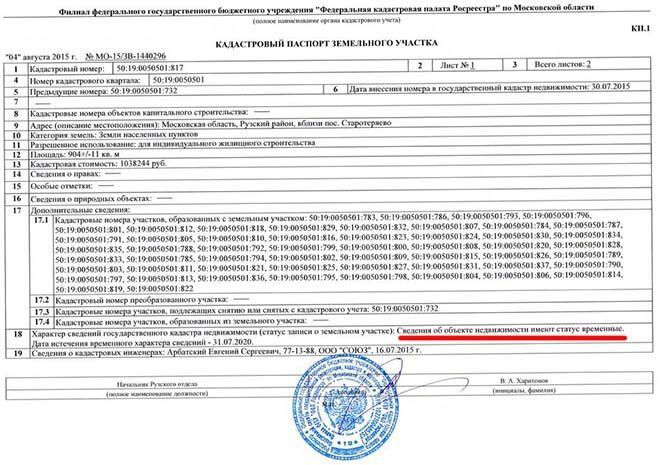Quite often, citizens are faced with questions that have legal implications and do not allow them to resolve the contradictions that have arisen without contacting a specialist. Moreover, contact a specialist who will help you prepare the necessary package of documents and adequately represent your interests in government agencies or even in court. One of these difficult problems is the issue of removing a land plot from the state cadastral register. Despite its apparent simplicity, in practice this situation causes many difficulties.
Cameraman Alisa Lawyer
Dear readers! Our articles discuss typical situations for resolving legal issues, but each problem is unique. Therefore, if you need a FREE consultation with a lawyer, call ext 946 (Moscow and Moscow region) ext 651 (St. Petersburg and Leningrad region)
Why are land plots removed from cadastral registration?
All land located on the territory of the Russian Federation is registered in the cadastral register. This information about the plots is systematized and entered into the State Real Estate Cadastre. During the use of the site, its area, purpose and other technical characteristics may undergo changes.
All these changes must be reflected in the cadastre, otherwise they will be considered illegal. We can talk, for example, about dividing one property into 2 equal ones.
To find out this information about the land plot, you need to order an extract from the Unified State Register of Real Estate for the property you are interested in.
In this case, the first, large plot should be subject to deregistration, and two new ones, on the contrary, will be subject to registration.
In addition to this case, there is also a direct instruction from the legislator regarding a temporary land plot, which must be followed and such land plots are also subject to deregistration.
The main regulatory act on the issue of deregistration of a land plot is the Federal Law of July 13, 2015 No. 218-FZ “On State Registration of Real Estate”. The law contains provisions regarding the competence of authorized bodies and answers the question of why plots are deregistered.
The consequences of removing a land plot from cadastral registration lie in one simple rule: it is impossible to remove a land plot from registration without its subsequent registration as a new property.
A site that has been deregistered should not be “lost”; instead, either new lands appear, or, after changing some characteristics, it will again receive its cadastral number.
We will tell you below how to remove a land plot from cadastral registration.
What is deregistration of a land plot?
Removal of a land plot from registration in the state real estate cadastre (GKN) is a legal action declaring the loss of legal capacity of the plot.
After a land plot has been removed from the cadastral register, the plot ceases to function in its former capacity , or its destruction and loss of functional characteristics are confirmed, which does not allow the subsequent use of the land for its intended purpose and the extraction of profit from it.
Grounds for deregistration from state registration
Changes may be made to the State Real Estate Cadastre, according to which a certain plot of land or parts of a plot of land are excluded from it for objective reasons.
There are several such reasons:
- plots that are formed from lands of state or municipal significance and for which no rights or encumbrances have been registered (“temporary” plots);
- plots that were registered more than 2 years ago, but during this time no registration actions regarding lease or ownership rights were carried out by their users;
- removal of a site previously taken into account, that is, the site undergoes transformations due to a change in area (for example, it is divided, expanded, etc.);
- no registration of property rights was carried out on the plot for more than a year after registration.

As we see, the range of grounds for withdrawal is limited and is not subject to broad interpretation. That is, for other reasons, the registration authority will not deregister the plot.
Another basis for excluding a site from the cadastre is a court decision that has entered into legal force. Quite often, such an act is required not in order to deregister a site on the grounds provided by law, but in order to abandon it due to non-use.
For example, by a court decision, a plot of land was deregistered in the State Tax Committee so that the copyright holder would no longer bear the tax burden. In this case, the owner of the land plot goes to court with a statement and evidence that the land plot is not being used for its intended purpose.
Here you can
>> Ask your questions to a lawyer (free).
Land status
Any land plot that is included in the Register and has a cadastral passport is an object of ownership. Each plot has its own individual characteristics, which are then included in the cadastral passport and distinguish such a plot from other similar ones.
What does the “deregistered” status mean? This means that all information in the Register has been abolished, and the plot itself has ceased to be an object of real estate, including someone else’s property.
Cases when a land plot can be assigned this type of status:
- All real estate objects for which there is data in the State Cadastral Register, until the time when such real estate is registered by the owner, will be considered temporary. Interesting fact: if the right of ownership, which was acquired as a result of various events, is not registered in the cadastral register within 5 years from the date of acquisition of such right of ownership and disposal, then the land plot automatically receives this status.
- In the event that such a plot of land ceases to exist as a result of certain manipulations with the land. For example, several land plots are being merged, or a land plot is being divided. The status itself appears in the cadastre within 3 days after the new rights to the newly formed plots are registered.
- In the event that a court decision was made to assign such status to the site and, thus, cease the existence of the object.
Thus, it turns out that the site can be deregistered as a result of the following manipulations with the land:
- Changing the territorial boundaries of the land;
- Enlargement of the site itself by combining several sites;
- Dividing the site into several small ones;
- In case an error was made in the cadastre, for example, double registration of a land plot.
In addition to these reasons, there may also be a reason that this land plot does not allow for territorial division with a neighboring plot. In this case, correct land surveying occurs with changes in their territorial boundaries.
Package of documents for submission to government agencies
Rosreestr, represented by its territorial bodies at the location of the site, is authorized to remove land plots from cadastral registration. However, the applicant, at his own discretion, has the right to choose one of 4 treatment options:
- Directly to Rosreestr through a personal visit to the government agency and submission of the entire package of documents. In this case, the applicant can also use the services of a representative. A mandatory requirement is the presence of confirmed credentials.
- Sending papers by mail. As a rule, this is done in the form of a registered letter.
- Visit to the MFC. During the organization’s opening hours, the applicant provides the collected package of documents to the operator and receives a receipt confirming their acceptance.
- Submit an application through the official website of Rosreestr in the “Electronic Services” section. In this case, the citizen or organization will need an enhanced qualification signature, since it is impossible to sign the submitted documents in any other way.
Regardless of the chosen method, the package of documents will be the same for all applicants. The legislator makes distinctions only in group affiliation with individuals or organizations.
Documents provided by citizens:
- Application for removal of a plot from cadastral registration. It is filled out in accordance with the sample provided at the exhibition stand in the Chamber or at the MFC in the amount of 1 piece. and is handed over to the person receiving the documents.
- Applicant's passport (original).
- Title documents for land plot. If the State Real Estate Cadastre does not have information about this plot, then the applicant must also provide a copy of the title document.
Documents provided by organizations:
- Application for deregistration in 1 copy.
- Applicant's passport (original).
- A copy of the power of attorney for the right to represent the interests of the organization.
- Title documents for land plot.
Important! The authorized person has no right to demand any other documents from the applicant, since this list of documents is closed. If questions arise regarding the site, they must be resolved through interdepartmental interaction.
Procedure
The entire procedure for deregistering a land plot is conditionally divided into several stages:
- Reception and registration of documents submitted by the applicant. At this stage, the interested person visits the government agency and submits the entire package of papers. The authorized person performs an initial check of the documents and issues the applicant a receipt of acceptance, which indicates the date of readiness of the documents. If the documents were sent by mail, then Rosreestr is also obliged to issue a receipt of their receipt, which is sent to the applicant by registered mail.
- The second stage is that the operator enters into the unified database of the State Real Estate Cadastre all information about this site, if it was not contained there, or any additional information if it is subject to adjustment in connection with the filing of an application to deregister the site.
- At this stage, all submitted documents are checked for compliance with established legal requirements. It is in this situation that the grounds for refusing to carry out the procedure for removing a site from cadastral registration are identified.
- This stage sums up the results of all the work of authorized persons of the state body and allows a decision to be made either to refuse to carry out the registration procedure, or to suspend registration, or to carry out the deregistration procedure.
The procedure for removing a land plot from cadastral registration is systematic and ongoing.
That is why the applicant, at the stage of filing an application (unless it is a matter of gross non-compliance of the documents provided with the requirements of the legislator), cannot be sure that state registration will end with the deregistration of the land plot.
Recognition of ownership of a land plot...removed from the cadastral register
Colleagues, I am interested in your opinion regarding the resolution of one very interesting incident.
The essence of the matter is this. A court decision recognizes a citizen's right of ownership of a land plot in the SNT. As individualizing features of this site, the court indicates the location of the site: number of the alley in SNT, number of the site along the specified alley; area, as well as cadastral number. The court decision comes into force. After this, the plaintiff, who, in order to enforce the court decision, turned to the cadastral engineer to draw up a boundary plan, since the boundaries of the site were not established, discovers that, it turns out, the site with this cadastral number has been canceled (removed from the cadastral register). The most piquant thing is that the deregistration occurred literally a month before the citizen applied to the court, and this information (about deregistration) was in the Unified State Register of Registration extract, which was requested by the court from Rosreestr. But neither the citizen who applied for recognition of the right to the court, nor the court itself took this information into account, and the operative part of the decision now includes the canceled cadastral number.
As it turned out, the deregistration of the land plot occurred on the basis of Part 3 of Art. 70 Federal Law of July 13, 2015 No. 218-FZ “On State Registration of Real Estate”, according to which “the registration authority in accordance with the established rules for maintaining the Unified State Register of Real Estate also removes from the state cadastral registration a land plot registered in the manner established by the legislation of the Russian Federation until March 1, 2008, if information about the copyright holders of such plots is not available in the Unified State Register of Real Estate.”
Thus, a citizen who has a positive decision on recognition of ownership of a land plot has a difficult question of executing this judicial act.
As you know, as a general rule, it is impossible to register rights to real estate if they are not included in the real estate cadastre. However, in this situation, the preparation of a boundary plan in connection with the formation of a land plot rests on the fact that the newly formed plot must be assigned its own unique cadastral number, while in the judicial act on the basis of cadastral registration and registration of rights a different cadastral number of this property is indicated .
Preparation of a boundary plan in connection with clarifying the boundaries of a land plot that has been removed from the cadastral register is also impossible due to the provisions of Federal Law No. 218-FZ dated July 13, 2015 “On State Registration of Real Estate.”
Still, having chosen the first option (preparing a boundary plan in connection with the formation of a land plot), the citizen applied to Rosreestr and received the quite expected notification of the suspension of state cadastral registration and state registration of rights.
Accordingly, at this stage the problem arose of choosing the correct trajectory for resolving the legal conflict that arose. What is the most reasonable and correct thing for a citizen to do to enforce an existing court decision? Here are some conceivable options:
- Applying to the court for clarification of the decision. There is a high probability of refusal to explain the decision, but it would be very interesting to look at the content of the decision if the court nevertheless agrees with the ambiguity of its act.
- Appeal to the court with a demand to Rosreestr to restore information about a land plot that was canceled and excluded from the real estate register . (There is such practice in the courts. For example, see the decision of the Odintsovo City Court of the Moscow Region dated June 10, 2020 in case No. 2-5527\2015. It is also possible to restore information about land plots canceled and excluded from the state real estate cadastre based on the decision The court is confirmed by the position of the Ministry of Economic Development of the Russian Federation in letter No. D23-879 dated March 4, 2011. The difficulty is that in the framework of such a case it is necessary to establish that the actions of Rosreestr to deregister the site were illegal, which is not observed in our situation, since deregistration took place before going to court).
- Applying to the court with a new claim for recognition of ownership of the land plot, only this time without indicating the canceled cadastral number. The problem here is that in fact this will be a dispute between the same parties on the same subject and on the same grounds as, according to Art. 134 of the Code of Civil Procedure of the Russian Federation is the basis for refusing to accept a statement of claim.
- Another probable way to eliminate the existing legal problem has already been used by the citizen - filing an application to correct a clerical error in the court decision (it was proposed to recognize as a clerical error the indication in the operative part of the decision on the canceled cadastral number). However, this, in a sense, a foppish method (and probably the simplest method) did not find support from the court and the correction of the clerical error was refused.
What can you advise in this situation? What other possible options for resolving this issue?
UPD. Actions to correct the clerical error did not yield results; filing an application for clarification of the decision also did not lead to a positive outcome, since the explanation that the court gave could not help in resolving the issue. However, while these processes were underway, Rosreestr independently restored the disputed land plot on the cad. accounting As a result, this story of a very long duration still ended with a happy ending :)
Deadlines
From the date of submission of the necessary package of documents for deregistration of a land plot, at least 18 working days must pass before Rosreestr makes a decision regarding the fate of the plot.
If the authorized person made a decision to deregister the site, then no later than 3 working days all changes are made to the State Real Estate Cadastre. The applicant does not need to submit anything to the cadastral chamber; everything is carried out in the order of information interaction between government bodies.
If the applicant is denied deregistration of the site, he is given time to eliminate all deficiencies in the submitted documents, after which he has the right to apply for the service again.
The cadastral service for deregistering a plot of land is free. Neither citizens nor organizations pay a state fee when applying.
What to do if a land plot is removed from the cadastral register?
They relate to the land surveying procedure and clarification of the boundaries of the site.
- Physical destruction of a site due to accidents at large enterprises, environmental disasters, and natural disasters.
- The information was entered into the State Cadastre temporarily.
- Registration of a plot of land was temporary; after a lapse of time, registration of ownership was not carried out.
- Judgment.
- Thus, only those circumstances under which the use of the site became impossible are listed. Registration procedure First of all, to deregister, you need to fill out an application. This document is drawn up and submitted by the owner himself, or his representative by proxy. The application is completed at the local branch of Rosreestr, at the address of the land plot.
What grounds could there be for refusing to provide a public service?
- The application was submitted by an inappropriate person (for example, those who do not have the right to represent the interests of the organization).
- A land plot is not an object of property, the state registration of which is authorized to be carried out by Rosreestr.
- The package of documents submitted by the applicant does not meet the requirements of the legislator.
- The plot of land cannot be transformed and, therefore, it is not possible to deregister the plot.
- The applicant did not eliminate the identified violations within 3 months from the date of refusal to deregister the site.
The decision of the authorized body to refuse must be handed over to the applicant and have a reasoning part, as well as a deadline for eliminating all deficiencies. The applicant has the right to appeal this act both to a higher authority and to the court.
Documents that are issued by hand
Based on the results of consideration of the submitted application for deregistration of the land plot, the applicant may be issued one of 2 documents:
- Decision to refuse withdrawal.
- Cadastral extract indicating the date of deregistration.
Here you can
>> How and where you can order a cadastral extract.
The applicant is not given any other documents. In addition, he does not need to go anywhere with the extract, since all changes to the cadastre will be made by an authorized operator.

Thus, the procedure for removing a plot from cadastral registration is aimed, first of all, at streamlining and systematizing all land plots located on the territory of the Russian Federation.
In the event of an unreasonable refusal to carry it out, the applicant has the right to appeal all decisions of the government body and defend his rights either in a higher authority or in court. If necessary, land plots will be removed from cadastral registration by authorized bodies on the grounds provided for by federal law.






